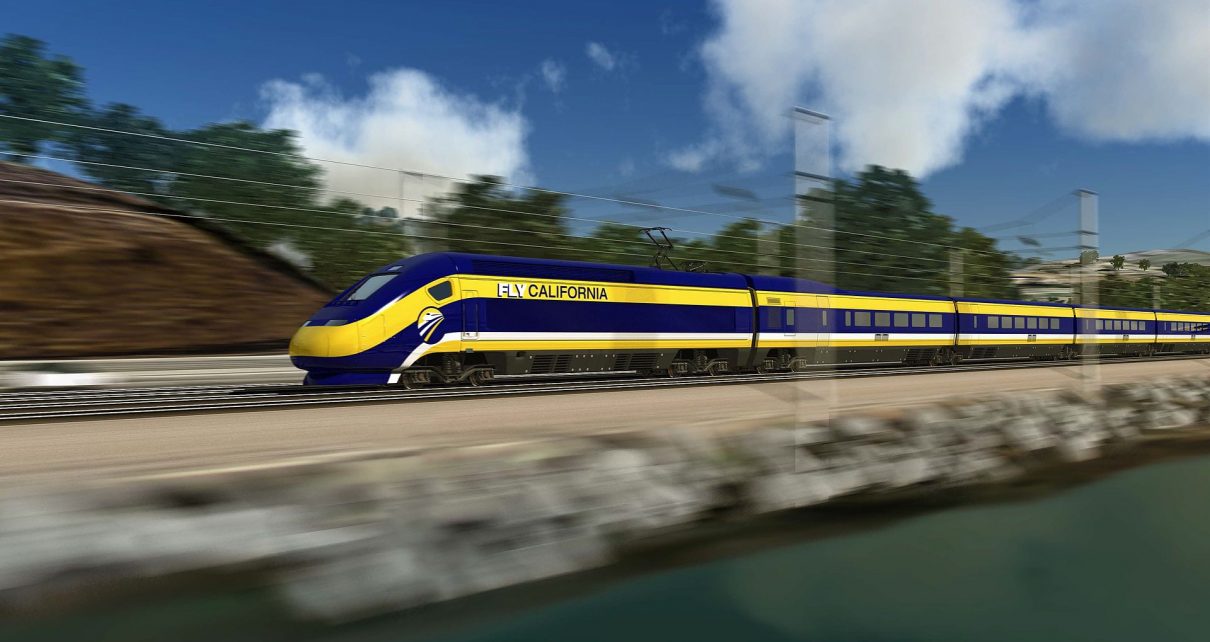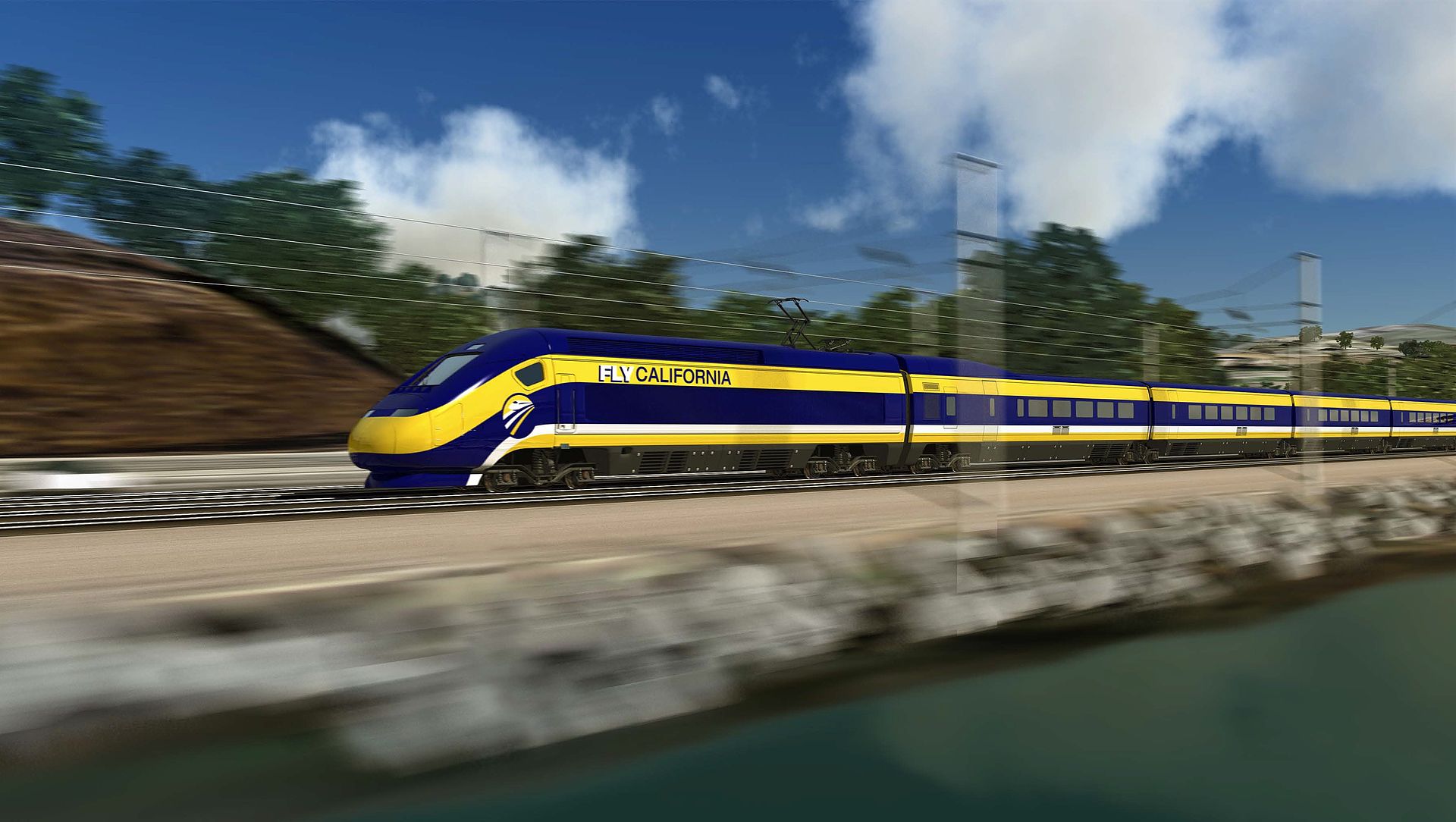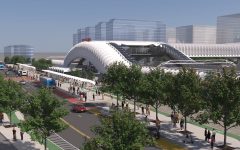
High Speed Rail train, artists rendering. (Photo: CHSRA.ca.gov)
Red Herring Alert: Comparing California and Japan High Speed Rail Falls on its Face
Japan’s high speed rail system, first begun in 1964, actually makes a lot of money
By Thomas Buckley, January 29, 2023 2:30 am
Well, it’s big in Japan.
That is what proponents of California’s high speed rail project say when asked about the whys and wherefores of the system. In other words, if it works somewhere else it will work here.
That argument, though, falls in the face of a rather basic fact: California and Japan are different.
It is true that Japan’s high speed rail system, first begun in 1964, actually makes money – a lot, in fact. The iconic first line, Shinkansen Tokaido, alone carries 90 million people a year and has an operating profit of about $4.4 billion dollars. That does not include capital costs, but teasing that number out after 60 years of operation and the privatization of the route in the late 1980s is extremely difficult – suffice to say the deal has “worked” for the owners.
There are multiple other Shinkansen lines in Japan, most of which also realize an operating profit (the latest expansion to Hokkaido – the very large island north of the Japanese mainland – has proven to be problematic, tough.)
Focusing on the Tokaido line – the line typically referred to for comparison – shows a few similarities but many glaring differences. It’s distance is 320 miles, not terribly different from the 390 miles from Los Angeles to San Francisco. Also, it takes two and half hours – again not too dissimilar – and, in a downtown to downtown comparison, is faster and more convenient than flying (though not cheaper – it’s about $100 to fly and about $160 to take the Shinkansen) just like California’s project is supposed to be.
But that’s about it.
First, there is the issue of population. The Tokaido line (with its “Nozomi” train only stopping in the largest cities and hence the fastest) runs from Tokyo to Osaka, which alone have combined populations of 17 million, compared to 11 million for LA (including the county) and San Francisco.
In the cities along the Tokaido route there are 9 million more people; in the space between LA and SF, there are less than 3 million. For comparison, the smallest city on the Tokaido is Shinagawa at 400,000 people; the smallest city on the California system is Gilroy, at 58,000.
All told, the average “stop population” between Los Angeles and San Francisco is about 250,000 – on the Tokaido/Nozomi it is 2,250,000.
It is these concentrations and the economies of scale they allow that drive the success of the Tokaido line – California’s system is simply not in the same league.
The Nozomi train operates 32 1,300-seat trains each way every day; pretty much on the half-hour with fewer overnight, while the two other slower (but still high speed) trains on the same system operate much more frequently and make many more stops.
Note on the following information– when dealing with California High Speed Rail (CHSR) Authority numbers – time or money – it is a good idea to remind oneself that they have never been right before, so really really big grain – meet salt.
The CHSR system will – in its “horizon year” of 2040, operate 105 southbound and 103 northbound trains per day over the system. Southbound, 64 trains will start in San Francisco, 20 in San Jose, and 21 in Merced. Northbound, 42 trains will start in Anaheim, 44 in Los Angeles, and 17 will start in Merced (note – that means 86 trains will pass through LA northbound every day.)
The system will operate 18 hours per day, with six hours designated “peak;” about half of the trains will operate during those six hours, the other half during the 12 “off peak” hours.
That means LA’s Union Station will – during the morning commute – see a train going north about every eight minutes, every day.
At 1,200 (could be a bit lower, could be a bit higher as the final design is not yet set) seats per train, about 10,000 people could leave LA between 7 and 8 a.m. For the system to hit its ridership (and therefore revenue) goals, about 5,000 have to.
Six trains will run non-stop from LA to SF and 10 will run with only stops at San Jose and Burbank – the non-stops are expected to meet the 2 hour and 40 minute time limit set by original bond; the other trains will not.
Like the Tokaido, California’s system will charge different fares for different distances traveled … sort of.
The 2020 ridership estimate report shows a ticket price (one way) of $100 from San Francisco to Bakersfield. The cost to travel to LA or even Anaheim? Also $100. It appears planners simply worked – in accordance with the original bond measure – backwards from a typical Southwest fare to set the cap.
For those traveling to/from smaller cities, the fares are obviously less. For example, San Francisco to San Jose is $26, San Francisco to Merced is $66, Los Angeles to Anaheim is $34, etc..
While the high-speed rail has been touted as a way to make lower cost Central Valley housing more accessible, the fare rates could significantly impact that desire as it would cost about $30,000 a year to commute from Merced into the city (admittedly, it can most likely be assumed there will be some sort of farepass/frequent user program will cut that price.)
But at numbers in the thousands per month, the incentive to move out of more expensive cities becomes far less – why spend the money on train fare rather than on a more expensive, more central home if it’s going to be a wash, unless you were going to move anyway to raise a family and mow the lawn?
As to overall finances, the most the CHSR says the LA to SF system will cost is $113 billion and it will be done in 2033, four years after the Central Valley “starter kit” is done.
Exactly where the money will come from remains a bit of a puzzle, but the CHSR is hoping the Cap and Trade money it gets will be extended to 2050 (an extra $10-20 billion,) that they will find more federal funds including non-transportation grants for things such as renewable energy and “social equity.”
As to a private investor, the CHSR admits they are not quite ready for that but that once the system is running and turning an operational profit businesses will come knocking to invest.
Speaking of operational profit, the CHSR projects there is a “99.4%” likelihood it make an operational profit by 2040. It should be noted “operational profit” is just that – how much more money you bring in than you have to spend every day and is not related to the capital cost.
If – IF – the system makes the $1.4 billion it expects to in 2040, that would give it a return on capital investment of 1.4% percent. That’s not terribly good and may make private companies think again and again and again about investing.
In other words, if (not accounting for inflation) the CHSR simply saved its money to build the rest of the system – the San Diego, Sacramento extensions – it would take about 40 years of “profit” to cover the cost.
And those revenues figures are based on having about 1 million riders a week, about 140,000 a day, about 6,000 an hour, 100 a minute.
All this to be able to get from Fresno to Bakersfield for $63 six years from now.
That’s 20 bucks more than Amtrak charges today.
2022-Business-Plan-FINAL-A11Y- Benefit Fraud Problems and Solutions - November 7, 2024
- A Little Exit Poll - November 5, 2024
- Tomorrow’s Headlines Today! - November 5, 2024




A side note for context (despite it being in my notes and it having been in previous HSR stories, I forgot to put it in this item – mea culpa) : Currently about 2.5 million people fly each year between LA and the Bay Area – total.
About 700,000 currently take Amtrak to/from Bakersfield to Oakland and/or Sacramento.
That’s 3.2 million.
Obviously, a whole bunch of other people drive to and from and in between, but I don’t think it is unreasonable to wonder if the 50 million annual riders the HSR estimates will use the system may be just a little bit on the optimistic side.
It is my view that the choo choo was conceived as a loser requiring endless subsides to keep this black hole of union jobs and political contributions going.
$26 to go from SF to San Jose in 30 minutes would be much cheaper and faster than Uber.
Lies,and more lies !
THIS IS WHAT YOU GET FROM CALIFORNIA GOVERNMENT !
This will never happen.
It is still unclear to me how HSR is supposed to go from the Bay Area and into the San Joaquin Valley then exit the SJV and proceed to LA. My understanding is HSR kind of needs to be routed along flat or gently sloping land, whereas the entry and exit of the SJV is pretty much…mountainous?
This information is not too hard to find. To get from the Bay Area, they will tunnel through the Pacheco Pass in order to minimize the grade of the tracks. In order to go from the SJV to the LA basin, they plan to tunnel through the Tehachapis, with the same strategy in mind, then to tunnel through the San Gabriel Pass into Burbank.
Here are links to the project documents for the sections I mentioned
Bay Area to SJV: https://hsr.ca.gov/wp-content/uploads/2022/02/Final_EIRS_JM_V1-06a_Summary_English.pdf
SJV to Mojave Desert: https://hsr.ca.gov/wp-content/uploads/2021/06/BP_Final_EIRS_Vol_1_Summary.pdf
Mojave Desert to Burbank: https://hsr.ca.gov/wp-content/uploads/2022/08/PB_0_Summary_Rev11_Clean_A11Y.pdf
Thanks Marcus. I appreciate your diligence.
“Speaking of operational profit, the CHSR projects there is a “99.4%” likelihood it make an operational profit by 2040.”
Right. We are supposed to believe the people whose jobs depend on this boondoggle. Democrats will lie through their teeth if it meets their objectives. I call BS on this.
And what about the $5400 this train is going to cost to build for every man, woman and child in this state?
Bureaucracy overmanaging and inflating the price of something so straightforward. Shaking my head on this one. Looking forward to the high speed rail from Rancho Cucamonga to Las Vegas though. Privately owned makes it happen.
Lol! Keep crying like a little bitch chained to your addiction for 18th century combustion engines. Hilarious to watch.